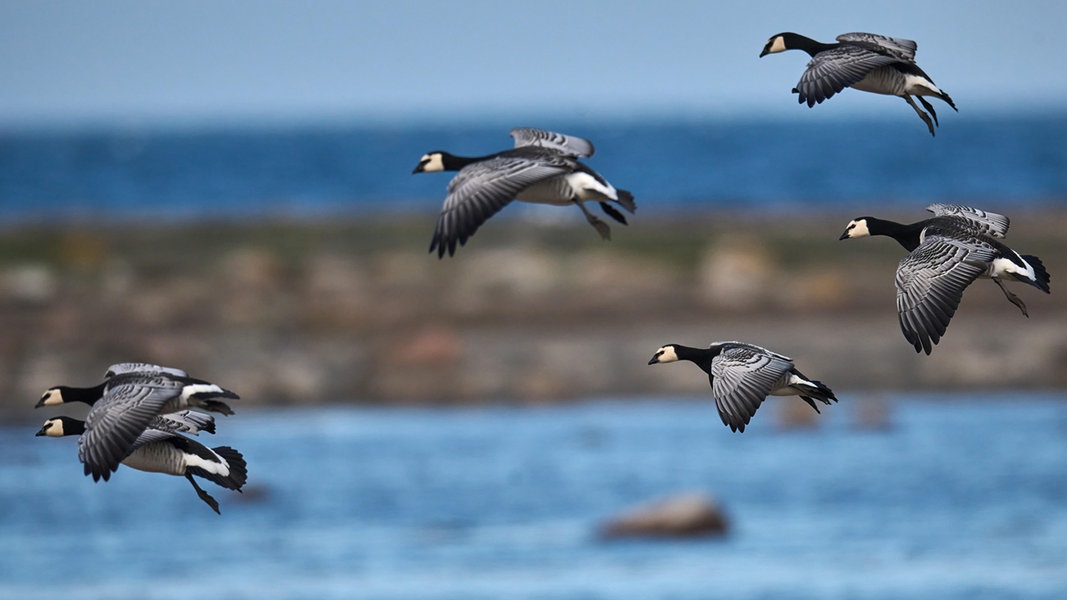As of: April 4, 2024 12:32 p.m
The coasts and waters of northern Germany are a true El Dorado for bird lovers in spring. From April onwards, tens of thousands of geese gather on the North Sea alone. Where can you observe which species now?
Many migratory birds return from their winter quarters in spring and begin to breed. Other bird species rest for a few weeks on the North and Baltic Seas and recharge their batteries there until they fly further north. They find a lot of fresh grass on the coasts. Depending on the destination and the weather, they leave again until around mid-May.
Barnacle geese on the North and Baltic Sea coasts
Barnacle geese can be easily recognized by their black neck and white cheeks.
Geese in particular can be seen in large numbers in the north in spring. Tens of thousands of barnacle geese, also known as barnacle geese, gather on the North Sea coast and islands in April. The largest number is usually found near Westerhever north of St. Peter-Ording. Also along the Baltic Sea coast – for example on Fehmarn, on the Darß and in the Geltinger Birk – the geese eat their fill until the beginning of May. Only then do they move further north.
Greylag geese and ducks breed near rivers and coasts
Greylag geese stay in northern Germany throughout the summer and raise their brood here. In the foothills of the Elbe near Hitzacker they occupy their territory in spring and begin to breed. Various species of ducks also live in the wet meadows and coves along the coasts as well as on lakes and rivers.
A special, recurring event is the resting of the brent geese. Up to 50,000 of the dark-bellied birds build up energy reserves in the lush meadows of the Halligen for the long flight to the Siberian breeding areas. They move on from mid-May. The region celebrates the natural spectacle with Brent Goose Days. From April 12th to May 12th there will be hikes, guided tours and lectures on the Halligen and some North Frisian islands.
Watch sea eagles on the Baltic Sea
With wingspans of two meters or more, flying sea eagles are an impressive sight.
If you want to watch sea eagles, you should go to the Baltic Sea. The impressive birds are represented in larger numbers, especially around Rügen and the Darß. Inland, the Mecklenburg Lake District, the Lower Saxony lakes Dümmer and Steinhuder Meer and the Elbtalaue are eagle territories. Here, bird of prey lovers can also see red kites, black kites and, with a bit of luck, a peregrine falcon.
Cranes and herons near the Baltic Sea
Cranes breed as early as April. They are clearly visible on the Pevestorfer meadows in the Elbe floodplain. At Darßer Ort you can at least hear them, as the tall grass usually obscures the breeding animals. There are also breeding pairs on Rügen. The shallow inland waters in the coastal hinterland are often ideal areas for gray herons, great egrets and swans.
Waders like shallow water
Oystercatchers can often be observed in the North Sea and are easily identified by their plumage and red beak.
The large family of wading birds can be found wherever there is shallow water. They arrive between March and May. Curlews, oystercatchers, black-tailed godwits, avocets, redshanks, greenshanks and knots take advantage of the good conditions in the North Frisian Koogen, in the Katinger Watt, in the Bodden waters of Western Pomerania, in the Dollart and Rheiderland near Emden, in the Rantum basin on Sylt, on the island of Kirr near Zingst or in the Wallnau water bird reserve on Fehmarn. There you can also easily spot ringed plovers from observation huts. During a walk on the Grüner Brink on the north coast of Fehmarn you can also experience numerous migratory birds that fly over this headland in order to have to fly over the open sea as little as possible.
Watch storks in the Elbe floodplain
If you want to observe storks, you have a good chance in the Elbtalaue. There are many nests there. Up to 18 couples have settled in the so-called stork village of Wahrenberg alone in recent years. Storks nest scattered throughout northern Germany, including on Rügen, in St. Peter-Ording and on the Dümmer. Ospreys are also at home in the nature park south of Diepholz.
Lummensprung on Heligoland
Guillemots breed on Heligoland’s rocks. In early summer the young animals dare to jump into the water.
A unique natural spectacle is the Lummensprung on Heligoland in June. A large colony of guillemots breeds in the rocks of the North Sea island. When the chicks, which are still unable to fly, leave their nests, they throw themselves in droves from the cliffs into the sea. There they continue to be looked after by their parents.
Bird watching with consideration
To protect the birds, especially ground-nesting birds, those interested should not leave the paths when bird watching and should definitely keep dogs on a leash. Since the animals are often at greater distances, it is advisable to bring binoculars with you.
Further information
4 Min
Great crested grebes, mute swans, greylag geese and common terns can be seen from the observation towers. 4 mins
4 Min
A total of 80 counters are being counted throughout the Schleswig-Holstein Wadden Sea – the majority of which are volunteers. 4 mins
South of Zingst lies the almost unknown paradise of Kirr. Visitors are allowed to enter Bird Island on guided tours. more
This topic in the program:
Hello Lower Saxony | June 17, 2023 | 19:30 o’clock
